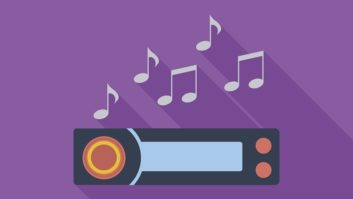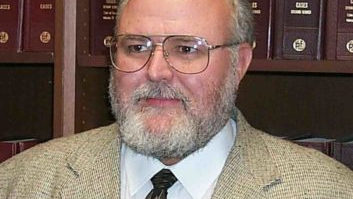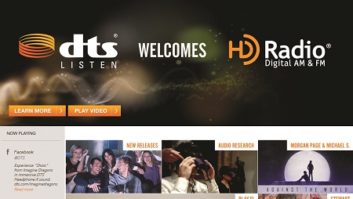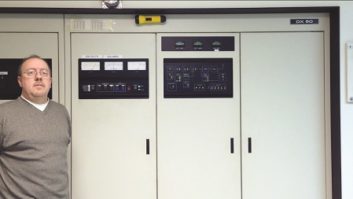
The author’s 2012 skywave IBOC listening gear consisted of a GE Superadio III and a borrowed Radiosophy HD100 digital receiver, along with a large tunable loop antenna that was used for signal peaking and interference rejection. (The small AM loop shown was supplied with the Radiosophy receiver.)
September marked the five-year point since the FCC first allowed AM radio stations to keep IBOC exciters switched on after dark. Readers may recall that I was there “at the listen” in 2007 to find out how this added digital baggage would affect reception and listenability of stations that had previously been available here in the eastern United States via skywave propagation.
My November 2007 article (“Is AM Skywave Broadcasting Finished?”) concluded that nighttime listening, post-IBOC, was a mixed bag.
Some stations were severely impacted by the wideband digital carriers transmitted by their neighbors while others remained listenable. Some of the success in main-taining a signal with “entertainment value” depended on where stations were geographically located. If they were at right angles to one another, it was usually possibly to reduce the digital hash by turning the receiver to null the offending carrier. Regardless, the commencement of nighttime IBOC operations did affect signals of several clear channel broadcasters to the extent that they were no longer usable.
I still listen to skywave radio (though not as much as before nighttime IBOC) and decided to recreate my fall 2007 listening experiment to see if there had been significant changes. (Some AM stations have abandoned nighttime — and even daytime — digital operations since then.)
Five years ago I simulated “real-world” listening conditions by using only consumer-grade receivers — a Sangean CCRadio and a GE Superadio III. Also no outside antenna or other such reception “assistance” was employed.
In the 2012 experiment, the equipment list changed a bit. While the Sangean is still a sensitive and devoted receiver, somewhere during the past five years its LCD readout partially failed, making it difficult to easily ascertain frequency settings. So the GE and its analog tuning scale became my mainstay receiver.
Another change was in the form of an IBOC-capable receiver. As these are still not cheaply and readily available (at least with AM tuning capability), I borrowed a digital receiver (with digital tuning readout) for the evaluation. This was a Radiosophy model HD100 “certified HD” radio. Another addition was a homebrew indoor tunable loop antenna for boosting signals a bit and to allow me to more easily reject interfering stations.
Changes in the listening environment at my remote country home have been few — this past summer, the rural electric co-op replaced the 30-something-year-old 7.2 kV power distribution system running past my home. If anything, the new system is quieter than the old.
I spread my listening over several weekends in late September and early October.
Scanning The AM Dial
Just as before, I logged a goodly number of stations arriving via ionospheric bounce, finding some quite listenable and others submerged in digital hash. I did notice that several stations that once touted “HD broadcasting” had fallen back to good old Ancient Modulation.
I began at the low end of the dial, checking in first with Nashville’s WSM on 650 and noted that they were doing a great job of pushing out radio’s longest running show — the Grand Ole Opry — to both of my receivers. As the station has elected not to do IBOC even in the daytime, there was nothing to muddy the waters in terms of raised noise floor, or a side attack on the station’s NYC neighbor, WFAN on 660. While WFAN does run IBOC from time to time, it shuts off the digital carrier during live sporting events to keep portable radio-carrying stadium fans happy. This was one of those nights, so I found no IBOC there either.
The HD100 signals presence of a digital signal and impending decoder lock with a brightly flashing blue LED. When there’s enough stable signal the flashing changes to a continuous glow.
I was encouraged when the blue LED on the HD100 began flashing, indicating the presence of an IBOC carrier. However, even after several minutes of listening and playing with both the receiver’s external loop antenna and my tunable loop that was radiating into it, the best the radio could do was only blink its light. Digital lock was never achieved no matter what I did. (This went as far as detuning and physically removing my “booster” tunable loop, just in case it was sucking out IBOC sidebands at resonance — not likely, as the loop’s “Q” isn’t really that great, but I had to be sure.)
I momentarily checked in with Chicago’s WSCR on 670. Decent signal — no IBOC light observed.
Moving up to 700, I found Cincinnati’s “Big One” (WLW) wasn’t so big anymore, as it was being cut down to unlistenable size by IBOC splatter from the upper adjacent, New York’s WOR. When I tried tuning to WOR itself, I got plenty of blue light flashing on the HD100, and for just a few seconds a solid lock indication, but before I could evaluate the station’s digital sound it was washed out by a Spanish language co-channel transmission (most likely from Cuba).
However, this was not really a loss, as WOR was running the same dull programming I’d observed in 2007 — an infomercial, which no amount of digital signal would have helped. (Actually the “jammer” and its Spanish language music were more entertaining than the program-length commercial it blanketed, even if I didn’t understand the lyrics.)
The next stop was at the dial position of another old friend, Chicago’s WGN on 720. Unfortunately, just as soon as the ionosphere wrinkled a bit, it was blasted into the ground by WOR. I quickly moved up to the 740 slot that the Canadian clear, CFZM (“AM 740”) calls home. This station does a very good job of sending a variety of music into most of Canada and the eastern half of the United States during nighttime hours. It literally booms into Northern Virginia and provides a welcome relief from the incessant political rants, sports talk and infomercials that emanate from most large stations south of the U.S.-Canadian border. No IBOC dings here either, as the “local” adjacent (Alexandria, Va.) on 730 runs very low nighttime power and gave up on IBOC some time ago. The upper adjacent, Atlanta’s WSB, also seems to have thrown in the towel on IBOC.
Detroit’s WJR on 760 (no IBOC) was generally listenable; but not so its upper neighbor, WABC. That 770 kHz operation suffered seriously from IBOC noise generated by Chicago’s WBBM on 780. As the interference was so strong, I suspected (correctly) that ’BBM was skipping in with a monster signal and I moved up 10 kHz to check this out.
Bingo! I got a solid IBOC lock and just a taste of nighttime digital MW reception. However, this was not to last — in less than 30 seconds the HD100’s LED started flashing and the decoding fell back to plain old AM. I stayed with ’BBM for quite some time, hoping for another IBOC lock, but it never
happened.
Another Canadian, CKLW, was there at 800, but wasn’t listenable due to the hash kicked out by Schenectady’s WGY on 810. ’GY itself was listenable on both receivers and triggered a flashing blue light, but never locked up the IBOC decoder. The station also handily took out Ft. Worth’s 820 WBAP operation; however, it was aided and abetted by upper adjacent WCCO in Minneapolis (which was received well on the Superadio but didn’t manage to produce a lock on the HD100).
WHAS on 840 put in its usual solid nighttime signal. Interestingly, the station touted “HD” operation early on but five years later doesn’t talk about it anymore. A little further up the dial both WWL in New Orleans (870) and WLS in Chicago (890) were getting hammered hard by IBOC from New York’s WCBS (880).
A longtime nighttime favorite of mine is Des Moines, Iowa’s WHO on 1040. However, ever since Boston’s 1030 WBZ added IBOC, WHO has suffered greatly and I’d written it off as non-listenable. On my first night of experimentation, this was still the case, with ’BZ wiping out not only WHO but also jamming KDKA on 1020. Same old story with trying to decode digital though — WBZ flashed the light, but never locked. On a subsequent night though, I was pleasantly surprised to find both WHO and KDKA quite listenable. Either ’BZ had dropped its IBOC carrier that evening, or the received signal strength from Boston was so low that the first adjacents triumphed.
Strange Behavior
I know that station-by-station reporting might be boring, so I’m going to stop and just highlight some of my listening experiences.
I rapidly moved through the rest of the “10s,” as there’s not much left anymore; KYW on 1060 has never done much here at night; there’s a mishmash of co-channels on 1070; Hartford’s 1080 WTIC doesn’t do a great job of delivering the goods; and Baltimore’s 1090 WBAL has been hammered into the ground by adjacents WTIC and WTAM (1100) ever since nighttime IBOC started.
Things got a bit interesting when I hit the “1100s,” however. Even though Cleveland’s WTAM puts in a super nighttime signal here, all it could do was flash the IBOC light. Curiously, it still wiped out ’BAL, but didn’t seem to touch Charlotte’s WBT on 1110. Asymmetric IBOC sideband operation? Enough signal strength from ’BT to override the hash? I wish I owned a spectrum analyzer.
The same sort of thing happened when I tuned up to 1120 for KMOX in St. Louis. Its signal pinged the blue LED (never locking though). Lower neighbor WBT was fine, but KMOX did a great job of trashing the 1130 upper adjacent, WBBR in NYC. I witnessed this particular phenomenon on multiple occasions. It was always the same: terrible WBAL, great WTAM, great WBT, great KMOX, terrible WBBR reception.
Despite triggerings of the IBOC lamp on many occasions, I only succeeded in getting a lock on the one occasion previously mentioned.
Conclusions
The late John Battison once mentioned to me that he thought the “HD” in “HD Radio” stood for “highly disappointing.” After my experimentation with the Radiosophy receiver, I have to agree.
While it may have some benefit to the handful of FM listeners who have equipped themselves with “HD” radios, I have to conclude that as concerns AM, it serves as nothing more than legalized jamming. (And the Cubans, at least, jam with music, not noise.)
I did observe in this latest listening test that at least some of the original IBOC nighttime adopters had switched it off.
I asked the transmitter supervisor of one of these 50 kW operations (part of a medium-sized group) where the decision had come from — group operations, CEO, station manager, PD maybe? — and was told that it had been arrived at solely between himself and chief engineer. Seems that when the IBOC exciter was powered down, no one outside or inside the station complained.
I also discovered an interesting website that chronicles AM HD ops. Managed by Barry McLarnon, it’s appropriately called “AM IBOC Stations on the Air” and will be interesting reading if you’ve followed me this far. The site — http://topazdesigns.com/iboc/station-list.html — indicates (as of this writing) that of the 307 AMs listed, 202 are currently running IBOC, with about a third — 67 — doing nighttime IBOC. The site also provides information on when, and sometimes why, IBOC ops were suspended:
IBOC said to be off due to listener complaints
Off for Yankees games
Off for live sports
Off since ownership change
Off since antenna rebuild in 2011
It might be interesting to examine listener response files from these IBOCers to see how many complaints were received when the HD exciters were powered down, or conversely, how many compliments were received when nighttime IBOC ops were initiated. I suspect that the number of either of these responses is vanishingly small.
Maybe it’s time to give AM IBOC up altogether. As witnessed, skywave-delivered IBOC doesn’t work. Perhaps the clears that persist in operating in that mode at night might want to think about applying for a reduction in power, as the only digital benefit would be to local listeners (and how many of these there really are is highly debatable). At the 50 kW level, the only thing these stations are accomplishing is jamming their adjacent brethren. If you’ve really got to hang in there with a digital signal (and I can’t understand why), at least be a good neighbor, and cut your power bill in the process!
Daytime operation seems to be proscribed too by the very nature of the AM broadcast band. Modern technology (light dimmers, cell phone chargers, CFLs, etc.) has injected a tremendous amount of man-made noise into the lower end of the spectrum. (Witness the scramble by TV broadcasters to vacate the lower VHF channels during the digital changeover.) You cannot decode a digital signal if it’s blanketed by noise — period!
By day, James O’Neal is technology editor of TV Technology magazine and a contributor to Radio World. Opinions expressed are his own.
Comment on this or any story. Write to [email protected], attention Letters to the Editor.











